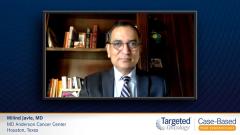
Recent Changes in the Cholangiocarcinoma Treatment Landscape
Dr Milind Javle discusses novel therapies recently approved or under investigation across multiple lines of therapy in patients with cholangiocarcinoma.
Episodes in this series

Transcript:
Milind Javle, MD: The past year-and-a-half has been truly remarkable for cholangiocarcinoma for the patients and for the providers. We have now 3 drugs that are approved. In the FGFR field, we have infigratinib, like I described, as well pemigatinib. For those with IDH1 mutation R132, ivosidenib is an approved drug in that situation. Clearly patients have options with targeted therapy, which I feel are much more tolerable and superior to systemic chemotherapy, and these options didn’t exist just over a year ago. It’s an exciting time for us.
Pemigatinib was the first drug to be FDA approved for the treatment of FGFR fusion cholangiocarcinoma, and the results are very remarkable. The response rate in the pivotal study called FIGHT with pemigatinib for FGFR2 fusion cholangiocarcinoma, indicated a response rate of about 35%, duration of response about 8 months, progression-free survival about 6 months, and overall survival of about 21 months. These are very encouraging results. Most of the people treated with pemigatinib had received this drug in the second line of therapy, so they were less treated. Regardless, there were several patients treated in the third and subsequent line, and they also seemed to do very well. Toxicities with pemigatinib are similar to that of infigratinib and include hypophosphatemia, some of the mucositis, and also patients can develop diarrhea, ocular toxicities. Several of these effects are class effects related to FGFR inhibition because these drugs are very specific inhibitors, therefore they have this class effect of toxicities.
There have been several other exciting developments that have not yet necessarily met the FDA bar for approval, but have become a part of the NCCN [National Comprehensive Cancer Network] guidelines now, such as the treatment of cholangiocarcinoma with BRAF V600E mutation. This mutation occurs commonly in melanoma and in about 5% of cholangiocarcinoma. Dabrafenib and trametinib, which is a combination of BRAF plus MEK inhibition, appears to be very effective with almost a 40% response rate, and is now in the NCCN guidelines. Our group performed a study with trastuzumab and pertuzumab, a combination that’s widely used in breast cancer. We investigated HER2-amplified biliary tract cancer, again a very promising signal, that was published recently in Lancet Oncology and we hope will meet the bar for NCCN guidelines.
Immunotherapy has been an amazing development over the past decade, and there have certainly been immunotherapy trials in cholangiocarcinoma as well. MSI [microsatellite instability]-high status in cholangiocarcinoma occurs in only about 1% of patients; for them, checkpoint inhibitors like pembrolizumab and nivolumab are very promising. In terms of patients with cholangiocarcinoma who are not MSI high, immunotherapy shows a signal that is quite modest. There was a KEYNOTE trial with pembrolizumab that enrolled over 100 patients, and the response rate seen was about 5.6%. There may be a tendency toward a somewhat higher response with PD-L1, but this is not proven. Nivolumab shows a similar response rate in a smaller study, about 10%.
There are now studies being conducted with immunotherapy in combination with targeted therapies, and we hope that with those types of combinations we will get a better signal. In the first-line setting, there are 2 important phase 3 trials. One is with gemcitabine and cisplatin plus or minus pembrolizumab. This trial has completed its accrual, and we hope that it will advance the cause of immunotherapy in the first-line setting. Similarly, there’s another trial called TOPAZ being conducted with durvalumab in combination with gemcitabine and cisplatin in Asia as well as in the Western world. The results of that trial are eagerly awaited.
Transcript edited for clarity.
---
Case: A 61-Year-Old Woman with Metastatic Cholangiocarcinoma
May 2019
Initial presentation
- A 61-year-old woman presents with jaundice and changes in stool and urine color.
Clinical workup
- Enlarged liver is palpable on physical examination
- Blood work reveals serum levels of CA 19-9 (1400 U/ml), bilirubin 2 mg/dL, ALT 550 U/L, AST 120U/L
- Patient undergoes CT imaging and is found to have multiple liver masses, consistent with metastatic disease or intrahepatic cholangiocarcinoma (iCCA)
- Histopathological examination identifies adenocarcinoma, CK7+, CK20-, HepPAR-, TTF- consistent with cholangiocarcinoma or upper GI Primary
- Patient is diabetic and somewhat non-compliant with her diabetes medication
- Her ECOG PS is 1
July 2019
Treatment
- Patient is treated with chemotherapy (gemcitabine + cisplatin) for 24 weeks.
- Patient is monitored for disease progression every 2-3 months by CT imaging.
July 2020
- Patient does well for 1 year after initiation of treatment but now has elevated CA 19-9 levels.
- MRI scans show several liver and bone lesions but no signs of brain metastases.
- Lab results are normal (absolute neutrophil count 4,000/mm3, platelets 150,000/ml, hemoglobin 12.1 g/dL
- Patient undergoes NGS testing (Foundation Medicine, Inc.) and is found to have FGFR2-BICC1 gene fusion
- Patient meets eligibility criteria for infigratinib phase 2 study and is enrolled in the trial and being treated with infigratinib
- Patient does not show any signs of disease progression on MRI scans for six months, suggestive of stable disease and CA19-9 levels stay within normal limits.







































